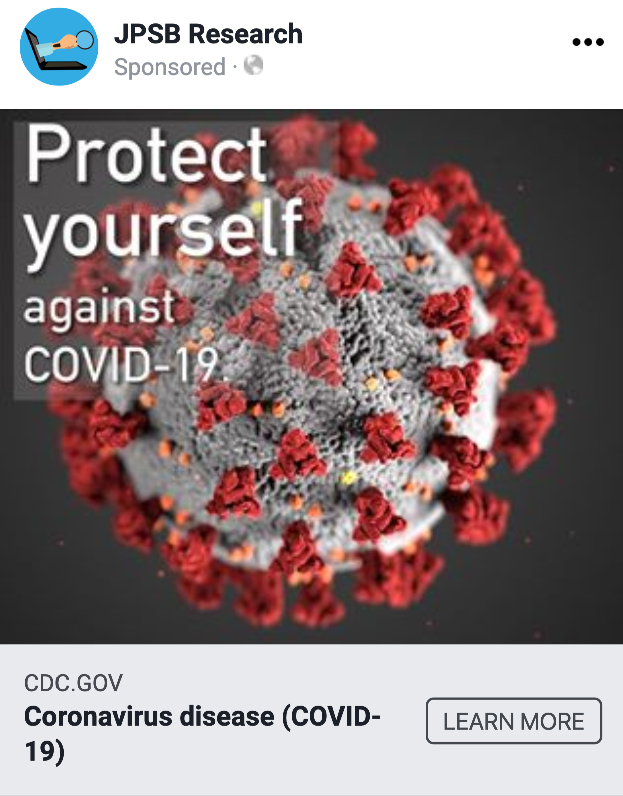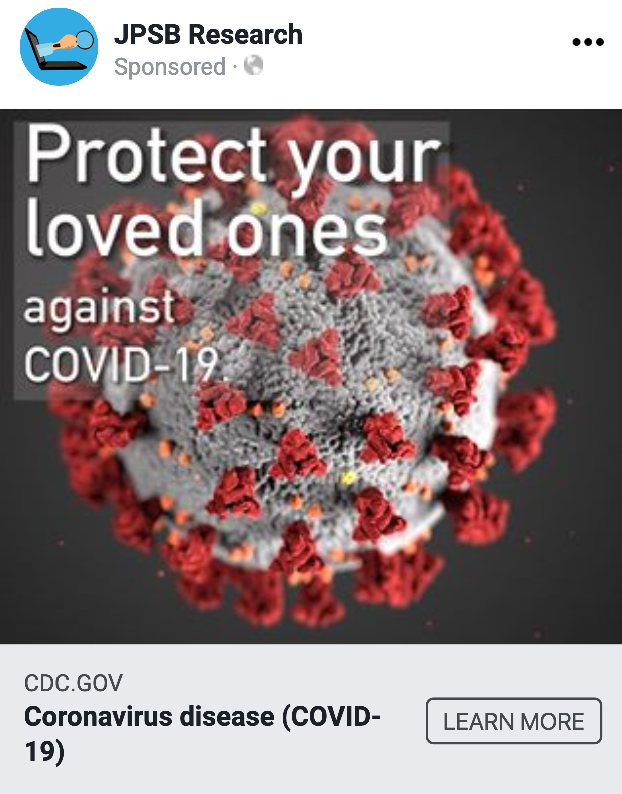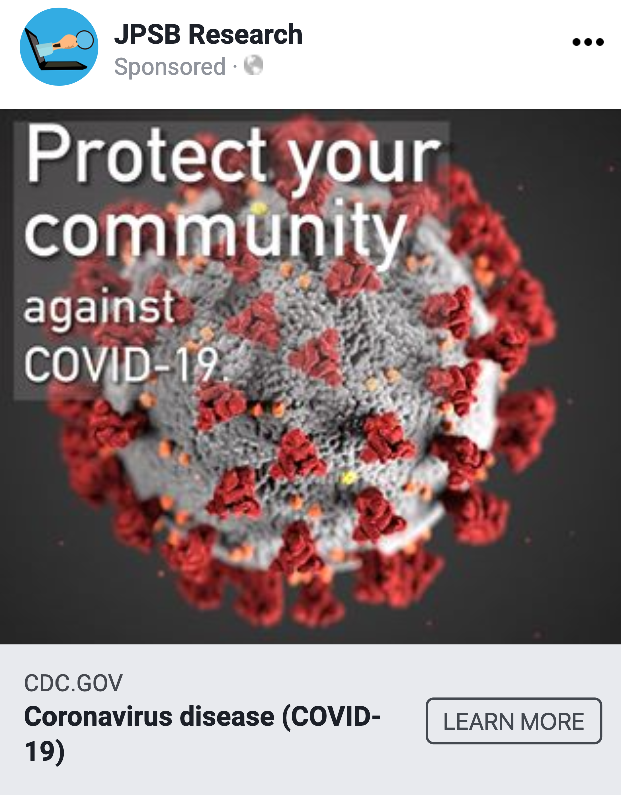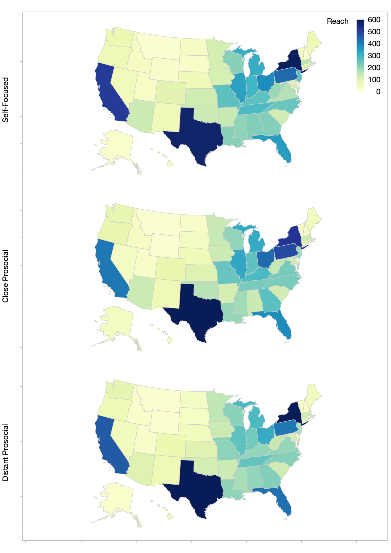


| Figure 1: Facebook Ad Stimuli (Self-Focused, Close Prosocial, and Distant Prosocial Framing). |
Judgment and Decision Making, Vol. 15, No. 6, November 2020, pp. 1037-1043
Evaluating prosocial COVID-19 messaging frames: Evidence from a field study on FacebookSachin Banker* Joowon Park# |
The rapid spread of COVID-19 has emphasized the need for effective health communications to coordinate individual behavior and mitigate disease transmission. Facing a pandemic, individuals may be driven to adopt public health recommendations based on both self-interested desires to protect oneself and prosocial desires to protect others. Although messages can be framed around either, existing research from the social sciences has offered mixed evidence regarding their relative efficacy. Informing this dialogue, in the current study we report on the findings of a field experiment (N = 25,580) conducted March 21–22 on Facebook during the critical initial weeks of the COVID-19 outbreak in the United States. We observed that ad messages using a distant prosocial frame (“protect your community”) were in fact significantly less effective than those using a self-focused frame (“protect yourself”) in eliciting clickthroughs to official CDC recommendations. However, ad messages with a close prosocial frame (“protect your loved ones”) were equally effective as the self-focused frame. These findings catalog the differential efficacy of ad messaging strategies during the early stages of the coronavirus pandemic.
Keywords: prosocial framing, social media, digital advertising, COVID-19
As the COVID-19 pandemic has spread throughout the world, local and federal governments, nonprofit organizations, and businesses have taken efforts to help slow the spread of the virus. One key element of these efforts has been the need to effectively communicate information about risks and prevention strategies to the public. However, in the modern-day social media environment where users are bombarded with new and conflicting information, reaching people with important public health messages can be fairly challenging.
Theory and evidence from the social sciences has the ability to play an important supporting role in aiding the dissemination of public health information and effectively coordinating individual behavior. In the current work, we report on the results of an ad messaging study conducted in the field during March 2020, the critical initial time period in which the coronavirus crisis began to emerge within the United States. By launching a set of advertisements on Facebook linking social media users to official recommendations from the Centers for Disease Control and Prevention (CDC), our goal was to examine how ad message framing may influence information-seeking behavior during the key initial weeks of the pandemic crisis.
Our study builds upon literature in the social sciences that has examined self-interested and prosocial motivations in depth (for recent reviews see Small & Cryder, 2016; White et al., 2020). During the outbreak of a contagious disease, people may be strongly driven to protect themselves against experiencing illness but may also be motivated by the desire to prevent spreading the disease and causing harm to others. Evidence supports the viability of messaging strategies appealing to either, in that both self-protective and prosocial motivations do indeed contribute to health-related decisions such as vaccination and hand-washing (e.g., Grant & Hofmann, 2011; Hershey et al., 1994; Vietri et al., 2012). Recent surveys also indicate that both appeal types are commonly used by nonprofit organizations (White & Peloza, 2009).
These messaging appeals tend to rely upon a combination of forces that simultaneously drive behavior. For instance, a crisis could unleash the inner Machiavellian nature of people to some degree, leading to hoarding behavior and competition with peers for limited resources, and such motivations could be leveraged by self-interested messaging appeals. Yet at the same time, people are often strongly driven to help others during crisis situations as altruistic desires to protect other people can be powerful and automatic (Khan et al., 2020; Rand & Epstein, 2014; Zaki, 2020), and these motivations could be channeled by prosocial messaging appeals. People may ultimately act based on the relative strength of these countervailing motivational forces.
While studies often center upon a dichotomous comparison between self-interested and prosocial messaging frames, in reality there exists a wide degree of latitude around how prosocial messaging may be constructed. Our current study indicates that the distance of the social group in focus can impact the efficacy of prosocial messages. This idea is consistent with related research which has shown that norms-based appeals are more effective in eliciting generous behavior when referencing ingroups rather than outgroups (Levine et al., 2005; Shang et al., 2008) as well as work documenting stronger responses from people when referencing more tangible victims (Galak et al., 2011; Small & Loewenstein, 2003). Similar to these findings, our data reveal that prosocial messaging referencing close social groups was more effective at increasing information-seeking behavior around how to prevent the spread of COVID-19, relative to prosocial messaging referencing distant social groups. Yet notably, we did not observe any advantage or disadvantage of using a close prosocial frame in comparison to a self-focused messaging frame.
Though we find that the self-focused messaging frame was more effective than the community-oriented prosocial messaging frame, it is important to note that the single study reported herein exists within a much wider literature that has documented a variety of different findings. The current study offers a unique snapshot in which we tested prosocial messaging strategies at the start of a pandemic crisis, on a major social media platform, and embedded within paid advertisements. While we believe that this study presents a valuable data point, readers should be careful to not overinterpret the present findings as a decisive evaluation of prosocial messaging strategies in general.
The efficacy of prosocial donation appeals has been shown to be fairly context-dependent (Duclos & Barasch, 2014; Savary et al., 2015; Simpson et al., 2018; White & Peloza, 2009; Zemack-Rugar et al., 2016). Within health-related settings in particular, evidence regarding the efficacy of prosocial messaging appeals has also been mixed. Some research suggests that certain prosocial messaging strategies are more effective at eliciting desired behaviors relative to self-focused messaging strategies. For example, Grant and Hofmann (2011) found that messaging focusing on patient safety rather than personal safety improved hand-hygiene behaviors. Jordan, Yoeli and Rand (2020) document that public message frames increased intentions to prevent the spread of COVID-19 relative to personal message frames, Luttrell and Petty (2020) observed that people considered other-focused arguments to be more persuasive, and Capraro and Barcelo (2020) report that community-oriented messaging increased intentions to wear face masks, although country-oriented messaging did not.
However, other research regarding vaccination decisions has documented mixed or inconclusive findings, indicating that messaging appealing to the public benefits experienced by others may have a small effect on individual behavior (Gerend & Barley, 2009; Hendrix et al., 2014; Isler et al., 2020). Additionally, recent studies comparing personal versus public messaging frames have documented no differences in outcomes. Falco and Zaccagni (2020) did not find differences in intentions to engage in social distancing and Bilancini et al. (2020) observed no differences in pandemic response comprehension.
In the current work, we catalog differences in prosocial messaging appeal efficacy which depend upon the distance of the social group in focus. The social distance of a group is often determined by the degree of interaction one has with other group members, and in some contexts is used to distinguish between kin and peers (Akerlof, 1997; Jones & Rachlin, 2006; Rachlin & Jones, 2008). Evidence from the experimental economics, psychology, and marketing literatures indicates that people generally tend to be more altruistic towards others who are closer in social distance (e.g., Charness & Gneezy, 2008; Galak et al., 2011; Hoffman et al., 1996; Kaikati et al., 2017; Levine et al., 2005; Shang et al., 2008; Small & Loewenstein, 2003). Correspondingly, we would similarly expect prosocial messaging appeals that reference more distant social groups to be less effective at eliciting desired behaviors relative to prosocial appeals that reference closer social groups.

Figure 1: Facebook Ad Stimuli (Self-Focused, Close Prosocial, and Distant Prosocial Framing).
We conducted a field study on Facebook in which we delivered advertisements to users in the United States linking them to recommendations from the official CDC website. To study the efficacy of prosocial and self-focused messaging appeals we varied the text on the ads and measured clickthrough rates.
The field study was conducted on Facebook over a 24-hour period spanning March 21–22, 2020 with a sample of 25,580 total unique Facebook users in the United States. The study was conducted in March 2020 in which public health recommendations involved hand-washing, social distancing, and self-isolating in order to minimize the spread of COVID-19 and flatten the curve. Each user was presented with only one of the advertisements on Facebook during this time period. Gender, age, and geographic distributions by condition are presented within the Appendix; these demographic variables were observed in an aggregated form.
Table 1: Total reach, clickthroughs, and clickthrough rates across conditions.
Condition Message Framing Clickthroughs Reach (Users Exposed) Clickthrough Rate Self-Focused Protect yourself 381 8,794 4.33% Close Prosocial Protect your loved ones 389 8,618 4.51% Distant Prosocial Protect your community 258 8,168 3.16%
The study was conducted as an ad split test on Facebook, building on prior research designs in marketing (e.g., Tucker, 2014). The split test essentially takes a sample from the target audience (i.e., U.S. users) and randomly presents each user with one ad from the ad set (i.e., one of the three different ads in our study). For each individual in the sample, the user was presented with an ad from the ad set when they browsed through Facebook; Facebook subsequently recorded whether the user did or did not click on the advertisement linking the user to the CDC webpage. The ads were launched simultaneously, were evenly split, and each user saw only one ad (i.e., users were not assigned to multiple conditions). These advertisements were shown to users in a naturalistic social media environment, as they looked through their own personal Facebook feed.
We designed three advertisements that varied in the message framing. In the self-focused condition, the ad prompted people to “protect yourself against COVID-19.” However, in the prosocial conditions, we varied the distance of the social group in focus. In the close prosocial messaging condition, the ad asked readers to “protect your loved ones” whereas in the distant prosocial messaging condition the ad asked readers to “protect your community.” Users who clicked on the ad were linked directly to the official CDC COVID-19 website. After clicking through, they could review current CDC recommendations on how to protect against the spread of the novel coronavirus. Users were informed that the information was a sponsored post from JPSB Research, and they were shown a button to “learn more” about the coronavirus disease from the cdc.gov website. The stimuli are shown in Figure 1.
We observed aggregate clickthroughs and exposures to the ads by condition. In order to evaluate how different messaging frames influenced individual information-seeking behavior during the COVID-19 crisis, we compared the clickthrough rates between conditions.
Table 2: Ad messaging efficacy contrasts.
Contrast Close Prosocial / Self Distant Prosocial / Self Close Prosocial / Distant Prosocial
We first present the raw data from the field study within Table 1. This table reports the total number of clickthroughs, total number of unique users reached, and the clickthrough rate for each condition.
To evaluate the impact of the ad message framing on user behavior we conducted a logistic regression of clickthroughs on condition. We contrast the three different conditions using pairwise comparisons applying the Tukey method and summarize the odds ratios and significance levels within Table 2. This analysis revealed that the distant prosocial message frame prompting users to “protect your community” actually was significantly less effective relative to the self-focused message framing to “protect yourself,” eliciting fewer clickthroughs. No differences were observed between the self-focused message frame and the close prosocial message frame that prompted users to “protect your loved ones”, although the clickthrough rate was nominally higher in the close prosocial condition. Finally, users who were presented with an ad with the close prosocial message frame prompting users to “protect your loved ones” were also significantly more likely to click through to the CDC recommendations relative to those who viewed an ad with the distant prosocial frame to “protect your community”.
These findings illustrate that the efficacy of prosocial messaging strategies can in fact depend upon the distance of the social groups in focus. Whereas the close prosocial messaging frame was approximately equally effective as the self-focused frame, the use of the distant prosocial messaging frame focusing on the general community of the user amounted in an approximately 27% loss in messaging efficacy relative to the self-focused frame and a 30% loss in messaging efficacy relative to the close prosocial frame.
In a field experiment conducted on a major social media platform, we examined the effectiveness of prosocial ad messaging frames in facilitating the dissemination of public health recommendations online. The current study focused on a behavioral outcome variable (clickthroughs), employed a large sample (N = 25,580), and was conducted within a naturalistic environment (Facebook). Testing three different ad versions, we varied the social distance of beneficiaries referenced in the ad. The advertisements linked users to current CDC recommendations on how to protect against the spread of the novel coronavirus and highlighted benefits either to oneself (“protect yourself against COVID-19”), to socially close others (“protect your loved ones against COVID-19”) or to socially distant others (“protect your community against COVID-19”). Our findings serve to emphasize that the distance of the social group in focus can influence the efficacy of prosocial messaging frames. When advertisements focused on a distant social group (“protect your community”), prosocial framing was significantly less effective than self-focused message framing, reducing clickthrough rates on Facebook from 4.33% to 3.16%. However, when advertisements instead focused on a close social group (“protect your loved ones”), prosocial framing was equally effective relative to self-focused message framing, with clickthrough rates of 4.51% versus 4.33%.
It should be noted that the findings from this study do not provide a conclusive answer to the general question of how one may optimize the delivery of public health messages to a population. Instead, our findings should be taken as a valuable snapshot that, when considered together with results from other studies, serve to inform the dialogue regarding the use of prosocial framing strategies in the context of public health messaging. Building on the current work, further research could identify how responses to health messaging may change at different time points or under different conditions. For example, after the extensive media coverage, habituation to the pandemic situation, and politicization of response strategies, people over time may respond differently or become desensitized to prosocial ad messaging frames referencing particular social groups. Additionally, the current findings apply primarily to relatively private settings, as participants viewed the advertisement while browsing through their personal feeds on Facebook. Further research could assess whether similar results manifest if prosocial-focused messages are displayed in more public spaces (e.g., through posters, billboards, and signs). White and Peloza (2009) found that whether a message is delivered publicly or privately can influence the relative efficacy of prosocial versus self-focused messaging frames. Thus, the public versus private context of the message could play an important moderating role in understanding when to apply prosocial messaging frames in disseminating public health recommendations.
We also study Facebook users in the United States in an aggregated form. Additional research may examine individual differences that could influence responsiveness to prosocial messaging frames. Some prior work, for instance, has suggested that conservatives tend to be more inclined to conform to group norms relative to liberals (Cavazza & Mucchi-Faina, 2008). Thus, community-oriented prosocial messaging frames that reference a political in-group could potentially be more effective among more conservative, rather than liberal, social media users. Other research also indicates that that normative influences are more powerful when linked to social groups with which people strongly identify (Kaikati et al., 2017). Thus, research could help to characterize how to effectively construct prosocial messaging frames that rely on a wider social group (e.g., “protect your fellow Texans” vs. “protect your community”). Because highly-targeted advertisements can increasingly be delivered with ease through social media channels, understanding how these and other factors influence the efficacy of prosocial messaging strategies can be important to optimizing the delivery of health recommendations to the public during a crisis.
Insights from the social sciences have the ability to play an important supporting role in guiding public health organizations in the efficient dissemination of health recommendations to the population. With greater messaging efficacy, health professionals may be able to more effectively coordinate individual behavior, which can minimize contagion and reduce harm. Our current study offers findings which may help us to better understand how public health messages can be more effectively distributed through social media channels and which we hope will spur additional research to further characterize the factors that influence prosocial messaging efficacy. We believe that a deeper understanding of these messaging strategies garnered from further study may enable us to better manage subsequent stages of the COVID-19 pandemic and arm us with knowledge that can help to prevent widespread outbreaks in future public health crises.
Akerlof, G. A. (1997). Social distance and social decisions. Econometrica, 1005–1027.
Bilancini, E., Boncinelli, L., Capraro, V., Celadin, T., & Di Paolo, R. (2020). The effect of norm-based messages on reading and understanding COVID-19 pandemic response governmental rules. ArXiv Preprint. https://arxiv.org/abs/2005.03998
Capraro, V., & Barcelo, H. (2020). The effect of messaging and gender on intentions to wear a face covering to slow down COVID-19 transmission. ArXiv Preprint. https://arxiv.org/abs/2005.05467
Cavazza, N., & Mucchi-Faina, A. (2008). Me, us, or them: Who is more conformist? Perception of conformity and political orientation. The Journal of Social Psychology, 148(3), 335–345. https://doi.org/10.3200/SOCP.148.3.335-346.
Charness, G., & Gneezy, U. (2008). What’s in a name? Anonymity and social distance in dictator and ultimatum games. Journal of Economic Behavior & Organization, 68(1), 29–35.
Duclos, R., & Barasch, A. (2014). Prosocial behavior in intergroup relations: How donor self-construal and recipient group-membership shape generosity. Journal of Consumer Research, 41(1), 93–108.
Falco, P., & Zaccagni, S. (2020). Promoting social distancing in a pandemic: Beyond the good intentions. OSF Preprint. https://osf.io/a2nys
Galak, J., Small, D., & Stephen, A. T. (2011). Microfinance decision making: A field study of prosocial lending. Journal of Marketing Research, 48(SPL), S130–S137.
Gerend, M. A., & Barley, J. (2009). Human papillomavirus vaccine acceptability among young adult men. Sexually Transmitted Diseases, 36(1), 58–62.
Grant, A. M., & Hofmann, D. A. (2011). It’s not all about me: Motivating hand hygiene among health care professionals by focusing on patients. Psychological Science, 22(12), 1494–1499.
Hendrix, K. S., Finnell, S. M. E., Zimet, G. D., Sturm, L. A., Lane, K. A., & Downs, S. M. (2014). Vaccine message framing and parents’ intent to immunize their infants for MMR. Pediatrics, 134(3), e675–e683.
Hershey, J. C., Asch, D. A., Thumasathit, T., Meszaros, J., & Waters, V. V. (1994). The roles of altruism, free riding, and bandwagoning in vaccination decisions. Organizational Behavior and Human Decision Processes, 59(2), 177–187.
Hoffman, E., McCabe, K., & Smith, V. L. (1996). Social distance and other-regarding behavior in dictator games. American Economic Review, 86(3), 653–660.
Isler, O., Isler, B., Kopsacheilis, O., & Ferguson, E. (2020). Limits of the social-benefit motive among high-risk patients: A field experiment on influenza vaccination behaviour. BMC Public Health, 20(1), 1–9.
Jones, B., & Rachlin, H. (2006). Social discounting. Psychological Science, 17(4), 283–286.
Jordan, J., Yoeli, E., & Rand, D. (2020). Don’t get it or don’t spread it? Comparing self-interested versus prosocially framed COVID-19 prevention messaging. PsyArXiv Preprint. https://psyarxiv.com/yuq7x
Kaikati, A. M., Torelli, C. J., Winterich, K. P., & Rodas, M. A. (2017). Conforming conservatives: How salient social identities can increase donations. Journal of Consumer Psychology, 27(4), 422–434.
Khan, U., Goldsmith, K., & Dhar, R. (2020). When Does Altruism Trump Self-Interest? The Moderating Role of Affect in Extrinsic Incentives. Journal of the Association for Consumer Research, 5(1), 44–55.
Levine, M., Prosser, A., Evans, D., & Reicher, S. (2005). Identity and emergency intervention: How social group membership and inclusiveness of group boundaries shape helping behavior. Personality and Social Psychology Bulletin, 31(4), 443–453.
Luttrell, A., & Petty, R. E. (2020). Evaluations of Self-Focused Versus Other-Focused Arguments for Social Distancing: An Extension of Moral Matching Effects. Social Psychological and Personality Science. https://doi.org/10.1177/1948550620947853.
Rachlin, H., & Jones, B. A. (2008). Altruism among relatives and non-relatives. Behavioural Processes, 79(2), 120–123. https://doi.org/10.1016/j.beproc.2008.06.002.
Rand, D. G., & Epstein, Z. G. (2014). Risking your life without a second thought: Intuitive decision-making and extreme altruism. PLoS One, 9(10), e109687.
Savary, J., Goldsmith, K., & Dhar, R. (2015). Giving against the odds: When tempting alternatives increase willingness to donate. Journal of Marketing Research, 52(1), 27–38.
Shang, J., Reed, A., & Croson, R. (2008). Identity congruency effects on donations. Journal of Marketing Research, 45(3), 351–361.
Simpson, B., White, K., & Laran, J. (2018). When public recognition for charitable giving backfires: The role of independent self-construal. Journal of Consumer Research, 44(6), 1257–1273.
Small, D. A., & Cryder, C. (2016). Prosocial consumer behavior. Current Opinion in Psychology, 10, 107–111.
Small, D. A., & Loewenstein, G. (2003). Helping a victim or helping the victim: Altruism and identifiability. Journal of Risk and Uncertainty, 26(1), 5–16.
Tucker, C. E. (2014). Social networks, personalized advertising, and privacy controls. Journal of Marketing Research, 51(5), 546–562.
Vietri, J. T., Li, M., Galvani, A. P., & Chapman, G. B. (2012). Vaccinating to Help Ourselves and Others. Medical Decision Making, 32(3), 447–458. https://doi.org/10.1177/0272989X11427762.
White, K., Habib, R., & Dahl, D. W. (2020). A Review and Framework for Thinking about the Drivers of Prosocial Consumer Behavior. Journal of the Association for Consumer Research, 5(1), 2–18.
White, K., & Peloza, J. (2009). Self-benefit versus other-benefit marketing appeals: Their effectiveness in generating charitable support. Journal of Marketing, 73(4), 109–124.
Zaki, J. (2020). Catastrophe compassion: Understanding and extending prosociality under crisis. Trends in Cognitive Sciences, 24(8), 587–589..
Zemack-Rugar, Y., Rabino, R., Cavanaugh, L. A., & Fitzsimons, G. J. (2016). When donating is liberating: The role of product and consumer characteristics in the appeal of cause-related products. Journal of Consumer Psychology, 26(2), 213–230. https://doi.org/10.1016/j.jcps.2015.06.001.
Gender | Self-Focused | Close Prosocial | Distant Prosocial | Total |
Female | 5286 (60%) | 5366 (62%) | 4806 (59%) | 15458 (60%) |
Male | 3454 (39%) | 3200 (37%) | 3322 (41%) | 9976 (39%) |
Uncategorized | 54 | 52 | 40 | 146 |
Age Group | Self-Focused | Close Prosocial | Distant Prosocial | Total |
18–24 | 418 (5%) | 390 (5%) | 480 (6%) | 1288 (5%) |
25–34 | 1072 (12%) | 1286 (15%) | 1180 (14%) | 3538 (14%) |
35–44 | 1894 (22%) | 1788 (21%) | 1646 (20%) | 5328 (21%) |
45–54 | 2072 (24%) | 1944 (23%) | 1744 (21%) | 5760 (23%) |
55–64 | 2268 (26%) | 2064 (24%) | 2018 (25%) | 6350 (25%) |
65+ | 1070 (12%) | 1146 (13%) | 1100 (13%) | 3316 (13%) |

Copyright: © 2020. The authors license this article under the terms of the Creative Commons Attribution 3.0 License.
This document was translated from LATEX by HEVEA.